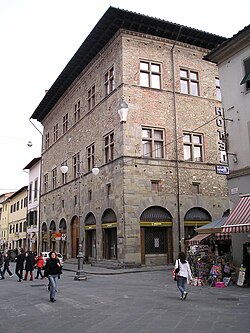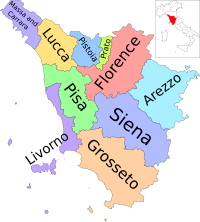Province of Pistoia
Province of Pistoia
Provincia di Pistoia (Italian) | |
|---|---|
 Palazzo Panciatichi in Pistoia, the provincial seat | |
 Map highlighting the location of the province of Pistoia in Italy | |
| Country | |
| Region | Toscana |
| Capital(s) | Pistoia |
| Comuni | 20 |
| Government | |
| • President | Rinaldo Vanni |
| Area | |
• Total | 964.12 km2 (372.25 sq mi) |
| Population (30 June 2015) | |
• Total | 291,815 |
| • Density | 300/km2 (780/sq mi) |
| GDP | |
| • Total | €7.302 billion (2015) |
| • Per capita | €24,986 (2015) |
| Time zone | UTC+1 (CET) |
| • Summer (DST) | UTC+2 (CEST) |
| Postal code | 51100 |
| Telephone prefix | 0573 |
| Vehicle registration | PT |
| ISTAT | 047 |
The province of Pistoia (Italian: provincia di Pistoia) is a province in the Tuscany region of Italy. Its capital is the city of Pistoia and the province is landlocked. It has an area of 964.12 square kilometres (372.25 sq mi) and a total population of 291,788 inhabitants (as of 2015).[2] There are 22 comuni (sg.: comune) in the province.[3]
The province was formed in 1927 under the rule of Mussolini, and had the lowest income per capita in Tuscany in 1966 due to high poverty levels. This is because the province was mainly agricultural before World War II ended, and has since had to rapidly progress towards industrial capitalism and abandon its agricultural roots.[4] The population of the province has recently been increasing, moving from 268,437 in 2011 to around 292,000 in 2015.[5]
The Mountains of Pistoia and the resorts Abetone and Val di Luce are tourist destinations for skiers, and the province contains a combination of flat land such as the area of the valley of the Ombrone and the river flowing through it, and mountainous land. The city of Pistoia is roughly 40 kilometres (25 mi) away from both Lucca and Florence.[6] The land around the cities of Pistoia and Pescia are popular locations for flower and plant cultivation for global exports, and town and commune Quarrata is known for its wood furniture.[6]
Government
[edit]List of presidents of the province of Pistoia
[edit]| President | Term start | Term end | Party | |
|---|---|---|---|---|
| 1 | Emanuele Romei | 1951 | 1956 | Italian Communist Party |
| 2 | Vincenzo Nardi | 1956 | 1964 | Italian Socialist Party |
| 3 | Luigi Nanni | 1964 | 1967 | Italian Communist Party |
| (2) | Vincenzo Nardi | 1967 | 1975 | Italian Socialist Party |
| 4 | Vasco Mati | 1975 | 1977 | Italian Communist Party |
| 5 | Ivo Lucchesi | 1977 | 1982 | Italian Communist Party |
| 6 | Vittorio Soldi | 1982 | 1985 | Italian Socialist Party |
| 7 | Riccardo Rastelli | 1985 | 1990 | Italian Communist Party |
| 8 | Aldo Morelli | 1990 | 1995 | Democratic Party of the Left Democrats of the Left |
| 1995 | 1999 | |||
| 9 | Gianfranco Venturi | 1999 | 2004 | Democrats of the Left Democratic Party |
| 2004 | 2009 | |||
| 10 | Federica Fratoni | 2009 | 2014 | Democratic Party |
| 2014 | 2015[7] | |||
| 11 | Rinaldo Vanni | 2015 | Incumbent | Democratic Party |
References
[edit]- ^ Regions and Cities > Regional Statistics > Regional Economy > Regional Gross Domestic Product (Small regions TL3), OECD.Stats. Accessed on 16 November 2018.
- ^ "Provincia di Pistoia". Tutt Italia. Retrieved 1 August 2015.
- ^ "Pistoia". Upintet. Archived from the original on 7 August 2007. Retrieved 1 August 2015.
- ^ John A. Agnew (1 October 2002). Place and Politics in Modern Italy. University of Chicago Press. pp. 129–. ISBN 978-0-226-01051-9.
- ^ "Popolazione provincia di Pistoia 2001-2014". Tutt Italia. Retrieved 1 August 2015.
- ^ Jump up to: a b "Pistoia". Discover Tuscany. Retrieved 1 August 2015.
- ^ Resigned.
External links
[edit]- Official website (in Italian)



